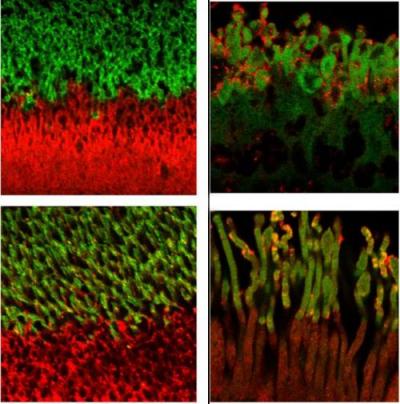
In healthy light-detecting cells (top), the photoreceptor rhodopsin (green) and inversin (red) proteins are contained in separate portions of the cell's antenna-like structures. However, in the light-detecting mouse cells missing complement factor H (bottom left) or with human cells with a high-risk age-related macular degeneration mutation (bottom right), the rhodopsin and inversin proteins overlap (yellow). Image credit: Proceedings of the National Academy of Science
Using laboratory-grown roundworms as well as human and mouse eye tissue, University of Maryland School of Medicine (UMSOM) researchers have identified a new potential mechanism for age-related macular degeneration (AMD)—the leading cause of blindness among older adults. The UMSOM researchers say that the findings suggest a new and distinct cause that is different from the previous model of a problematic immune system, showing that the structural organization of the eye’s light-detecting cells may be affected by the disease.
Dr. Vogel’s team found a worm version of complement factor H protein, which has previously been linked to AMD, located in the sensory neurons that help the worms detect chemicals, food, touch, and temperature. The protein appeared specifically in the middle region of the sensory neuron’s little antennas, known as cilia (that do the work of sensing the environment), just next to another known important antenna protein called inversin. However, in worms bred to lack complement factor H, they found the inversin spread throughout the antennas rather than remaining in the middle of the antennas.
The researchers confirmed their results in the light-detecting cells in tissue from human retinas.
The discovery offers the potential to identify new molecular targets to treat the disease.